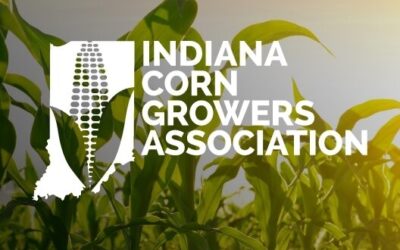Cover crops improving soil and water on Upper White River farms
BY ANN HINCH
In a 2019 Indianapolis Star report on the status of White River water quality, which flows through Indiana’s state capital, a city planning administrator observed, “When you take a shower in the morning, that’s the White River splashing in your face; when you drink that cup of coffee in the morning, you’re drinking the White River.”
The sprawling Upper White River Watershed spans multiple counties in east-central Indiana, channels rainfall and melting snow to creeks and streams. One of the major notes of the Star report was the types and amounts of pollutants entering the river – including farm fertilizers and herbicides.
One way to cut down on use of agricultural fertilizer in farmland is to improve soil’s ability to retain plant nitrogen – as well as retain more soil in the field rather than losing it to erosion. Crop scientists, for years, have been beating the drum on the benefits of planting cover crops as a method for doing both.
Six years ago, the Indiana Soybean Alliance (ISA) and Indiana Corn Marketing Council (ICMC) introduced its Upper White Cover Crop (UWCC) program. Corn and soybean growers, who sign up 40 acres of their land, receive fall aerial application of a cover seed mix free of charge. They can participate for up to five years as long as there are open slots in the program each summer. For the first year, a farmer must not already plant a cover crop.
“We, as Indiana farmers, are among the leaders in the nation in cover crop adoption, and we are just trying to increase adoption of cover crops and get farmers to plant them, year to year,” said Madeline Lilly, Sustainability and Value Creation project manager for ISA and ICMC.
In the 2017 Census of Agriculture, USDA reported Indiana ranked third in the nation for cover crop acres planted into corn and soybeans, at about 8.2 percent of those acres.
And according to a 2022 Conservation Survey conducted by the Indiana State Department of Agriculture and Indiana Conservation Partnership, the state’s farmers planted roughly 10 percent of all cultivated acres in over-winter, living cover crops – including wheat. This also included 550,000 acres of cover planted in corn and 780,000 acres in soybeans prior to harvest in 2021.
Soil vs. dirt
In previous years, ISA and ICMC have assisted with funding from the Walton Family Foundation through the American Soybean Association (ASA). Lilly said the 2023 signup will not be open until this summer, and details are still in progress. The state’s corn and soybean checkoffs use Beck’s Hybrids seed and partner with the Indiana-based, seed company for technical expertise.
Beck’s Small Seed Product Manager Ryan Moore as well as ISA and ICMC Sustainability and Value Creation Director Ben Forsythe, provide field sampling. Every year, new participants in the UWCC receive a nutrient test from their 40-acre cover plot as a baseline. Farmers each year also receive above-ground biomass sampling to measure nitrogen and carbon sequestration levels.
Moore talked about some of the advantages and challenges of cover-cropping during an ISA and ICMC lunch-and-learn program in mid-January. In addition to working for Beck’s, Moore and his father farm in Tipton County. He used examples from his fields as well as from other farms in his presentation.
By using cover crops and no-till, Moore said a farmer can increase soil organic matter by about one-quarter of 1 percent over a decade. That doesn’t sound like much, but a 1 percent difference in matter between two fields means the higher-organic soil can hold another 25,000 gallons of water per acre in its pores – not pooled on the surface, but down where plant roots can pull productively from it.
Moore said a grower can start seeing visible difference in the health of their land within 3-5 years of planting annual cover. “You have soil, versus what I call ‘dirt’ in a conventional tillage system,” he noted.
Farmers in UWCC have the cover seed broadcasted by plane in late August or early September to take advantage of rain to help establish the crop before the weather starts getting cool. Moore said the timing is also meant to be
convenient for farmers, and they don’t have to worry about buying the seed and running a planter. First-year participants are delivered a terminal oat/radish mix, while those in years 2-5 receive a non-terminal mix of oat, barley, crimson and rapeseed planted in corn or a winter rye and rapeseed mix planted in soybeans.
Cover is often paired with a no-till system but can also be used with conservation, or minimal, tillage practices. “It’s
such a different concept from what I was raised farming,” Moore said, referring to conventional tillage, which can result in crusted soil, compaction, deep ruts that don’t disappear and standing water that drains slowly. “Why were we ever tilling?”
Joe Rorick, who works as the On-Farm Sustainability Research and Project Coordinator for ISA and ICMC, said the
current UWCC project year signed up 60 farmers, including 15 new participants, with a total of 2,400 acres. The initial soil sampling is quite valuable, as it tells the grower what they have to work with, at first. He noted that a quarter of Indiana farmers don’t do any soil sampling and just apply nutrients to their crops without knowing how much, if any, is needed.
The chain of improvement begins with better soil biological activity, then improved organic matter turnover, better nutrient cycling, improved soil structure, and more water availability to the plant. Rorick noted the first visible results usually come at the stage of improved soil structure.
“We’re not talking about replacing tile drainage with cover crops … we’re talking about what we can affect, here,” he said. He wants farmers to be realistic about their gains, including improved water-soil permeability. “When our management of our soils creates a bad relationship with our most important input (water) then we start to have troubles.”
Real results
Mat and Julie Berger own 150 acres in Wayne County, where they plant corn and soybeans, as well as some hay and wheat. They also raise Shorthorn cows and fat cattle. The Bergers also work off-farm. Mat Berger is an ag loan
officer with Merchants Bank of Indiana.
This summer will be his third year to sign up for UWCC, but he’s hardly unfamiliar with cover crops – his dad, Don, has been using cover on his farm five miles away for about 20 years. Berger thinks he was probably one of the first growers in his area to implement the practice. “Dad’s always been a little more forward-thinking on that stuff,” he said.
Don used to grow hay, a natural cover, for his dairy cows. When he sold the herd, he didn’t feel right working the
ground right away, so he transitioned to no-till and cover crops. Now, he does plant cash crops in that ground, still
using cover.
In addition to any soil health benefits, Berger is looking for a way to work cover into his livestock program. If he can later establish a good stand of the right kind – such as cereal rye – in the field after harvesting corn and soy, he thinks he can graze cattle in the winter and spring and save on inputs and manure handling. “It can save you some labor, some feed costs, and it’s a little less facility involved.”
He intends to sign up with UWCC all five years and appreciates the chance to learn what works, and doesn’t,
without the typical expense of experimentation. “It just kind of gives you a lot of flexibility; you don’t have any money invested in it,” he pointed out.
“It’s really simple to use, really easy to sign up, and I’ve never been billed for anything. There’s no risk, so why not try something new if there’s no cost upfront?”
Planning on a fourth year
Another Wayne County grower, outside Greens Fork, Jeannine Winters owns 107 acres with her husband, Kevin. She grows soybeans and corn and, up until this year, had also raised tilapia for pond-stocking. Winters said the price of propane to heat the water has become prohibitive, for now. She is waiting to sign up for her fourth year in UWCC.
“It’s been different,” she said of how her cover stand turns out. “The first year we didn’t get much (growth); the second year, we got too much. This past year we didn’t get much again.”
In 2021, the cover mix grew so much between application and when her combine driver harvested the soybeans in November (because rain kept them out of the field earlier) he almost backed out because it was difficult to combine.
“That cover crop just absolutely took off,” she said, observing with some humor that it was also a great season for local deer seeking easy grazing.
She signed up for UWCC the first time in 2020 because her land has highly erodible ground, and she wanted to curb further erosion, plus she had a lot of weeds. She bought the property in 1995 but rented out the land to another farmer for years before deciding to work it herself. Her sons, Levi, 18, and Tristan, 11, help as well.
In comparison to the acreage she plants to cover, Winters has another 30 acres – separated by the driveway – where she is using traditional herbicide on weeds. For now, she said that burndown is beating out cover for controlling weeds. She has also noticed the emergence of shattercane, a sorghum-type weed that looks similar to corn, in the field growing the cover mix.
Winters has yet a third section of her farm, about 30 more acres, that is compacted and erodible and keeps developing big unwanted ditches. She grows wheat here and is looking into adding different cover crops to loosen and improve the soil, as well as installing drainage tile.
She likes participating in the UWCC program, especially attending the ISA and ICMC meetings to learn more about
cover, no-till and other “good information.” While her father worked on farms while she was growing up, they did not live on one, so she has to learn much about agriculture on her own.
“There’s so much to learn, you’ll never know it all,” she said. “It seems like practicing, all the time.”
To be added to the list for the announcement of the 2023 UWCC signup period, or ask questions about the program, email Madeline Lilly at mlilly@indianasoybean.com
Posted: March 20, 2023
Category: Indiana Corn and Soybean Post - Winter 2023, ISA, News




